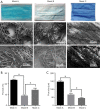Understanding the factors involved in determining the bioburdens of surgical masks
- PMID: 32042770
- PMCID: PMC6989980
- DOI: 10.21037/atm.2019.11.91
Understanding the factors involved in determining the bioburdens of surgical masks
Abstract
Background: Surgical site infection (SSI) continues to be one of the most common postoperative complications. In our previous study, surgical mask (SM) bioburden was identified to be a potential source of SSI. In the present study, we investigated the factors involved in SM bioburden.
Methods: Bioburdens of the disposable SM (A: medical mask; B: medical surgical mask) and newly laundered cloth SM (C) were tested by immediately making an impression of the external surface of the mask on sterile culture media. SM microstructure was observed using a scanning electron microscope (SEM). Filtering efficiency and airflow resistance were evaluated with TSI Automated Filter Tester 8130 (TSI Incorporated) according to GB/19083-2010. Whether speaking during operation and washing the face pre-operatively affect SM bioburdens was also evaluated. Surgical procedures were performed in a dynamic operation room. Fifty cases of mask use were enrolled in this study.
Results: The bioburden of mask A was the highest. The bioburden of mask B was the lowest. Mask C possessed the lowest filtering efficiency and the highest airflow resistance. SM bioburden was higher in the speaking group. SM bioburden showed no significant difference after washing the face, despite the finding that washing could significantly reduce facial bioburden.
Conclusions: Multiple factors influence SM bioburdens. Mask B showed the lowest bioburden and best protection effects. Mask C is not recommended to be used, especially considering that surgeons do not wash the cloth masks daily. Unnecessary talking during operation is not recommended, and washing the face before surgery is not strictly necessary.
Keywords: Surgical mask (SM); bioburden; mask type; speaking; washing face.
2019 Annals of Translational Medicine. All rights reserved.
Conflict of interest statement
Conflicts of Interest: The authors have no conflicts of interest to declare.
Figures





Similar articles
-
Optical microscopic study of surface morphology and filtering efficiency of face masks.PeerJ. 2019 Jun 26;7:e7142. doi: 10.7717/peerj.7142. eCollection 2019. PeerJ. 2019. PMID: 31289698 Free PMC article.
-
Surgical masks as source of bacterial contamination during operative procedures.J Orthop Translat. 2018 Jun 27;14:57-62. doi: 10.1016/j.jot.2018.06.002. eCollection 2018 Jul. J Orthop Translat. 2018. PMID: 30035033 Free PMC article.
-
Cotton and Surgical Face Masks in Community Settings: Bacterial Contamination and Face Mask Hygiene.Front Med (Lausanne). 2021 Sep 3;8:732047. doi: 10.3389/fmed.2021.732047. eCollection 2021. Front Med (Lausanne). 2021. PMID: 34540873 Free PMC article.
-
Effectiveness of face masks for the population.Ann Ig. 2021 Jul-Aug;33(4):347-359. doi: 10.7416/ai.2020.2390. Epub 2020 Dec 3. Ann Ig. 2021. PMID: 33258868 Review.
-
Facemask Alternatives in Veterinary Medicine in the Context of COVID-19 Shortages.Front Vet Sci. 2020 Aug 27;7:561. doi: 10.3389/fvets.2020.00561. eCollection 2020. Front Vet Sci. 2020. PMID: 33062649 Free PMC article. Review.
Cited by
-
A retrospective characterization of pediatric facemasks marketed in the United States and implications for future designs.PLoS One. 2024 Sep 19;19(9):e0307879. doi: 10.1371/journal.pone.0307879. eCollection 2024. PLoS One. 2024. PMID: 39298496 Free PMC article.
-
Biodegradable and multifunctional surgical face masks: A brief review on demands during COVID-19 pandemic, recent developments, and future perspectives.Sci Total Environ. 2021 Dec 1;798:149233. doi: 10.1016/j.scitotenv.2021.149233. Epub 2021 Jul 24. Sci Total Environ. 2021. PMID: 34329934 Free PMC article. Review.
-
Effects of mask-wearing on the inhalability and deposition of airborne SARS-CoV-2 aerosols in human upper airway.Phys Fluids (1994). 2020 Dec 1;32(12):123312. doi: 10.1063/5.0034580. Phys Fluids (1994). 2020. PMID: 33362401 Free PMC article.
-
Reuse of N95/PFF2 masks in clinical practice: morphological and structural analysis.Rev Lat Am Enfermagem. 2024 Jul 5;32:e4209. doi: 10.1590/1518-8345.7045.4209. eCollection 2024. Rev Lat Am Enfermagem. 2024. PMID: 38985043 Free PMC article.
-
Textile Masks and Surface Covers-A Spray Simulation Method and a "Universal Droplet Reduction Model" Against Respiratory Pandemics.Front Med (Lausanne). 2020 May 27;7:260. doi: 10.3389/fmed.2020.00260. eCollection 2020. Front Med (Lausanne). 2020. PMID: 32574342 Free PMC article.
References
-
- Scott RD. The DirecT MeDical cosTs of Healthcare-Associated Infections in U.S. Hospitals and the Benefits of Prevention. 2009.
LinkOut - more resources
Full Text Sources
Other Literature Sources
